Outsiders has done plenty to shake up the landscape of Flesh and Blood. In addition to new Classic Constructed heroes Uzuri and Riptide, legacy heroes Azalea and Katsu have been given new life.
As someone who has been playing Katsu nearly exclusively since early February, what began with one Welcome to Rathe draft dovetailed into endless hours of deck construction and theorizing. Bonds of Ancestry has made Katsu a genuine powerhouse and a serious contender for my deck of choice going into Pro Tour: Baltimore. However, that card alone is not enough to win games. Mostly, I’ll have to rely on his established play patterns; and without a wealth of current match footage to watch, I had to do my own investigating.
"How does Katsu win?"
We can better focus that question into,
“How does Katsu generate value?”
Value Beyond Damage
The most obvious ways that Katsu generates value are his above-rate combo cards and the extra cards he draws from Mask of Momentum or Whelming Gustwave.

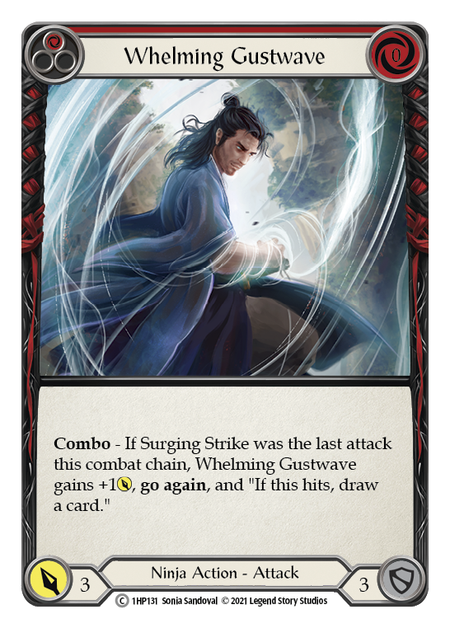
A combo-empowered Whelming Gustwave (R) attacks for 4 and threatens a card draw on hit. Without a 4-defense card, an opponent's options are quite limited. They can:
- Block with a card and equipment
- Block with 2 cards
- Let the attack hit
Letting the Gustwave hit is quite dangerous, so most of the time it should only be a last resort. In this scenario, blocking with a card and equipment would be the best option - but what if they have run out of armor? What if their armor forces them to block 5? If they can’t cover the attack perfectly, our attack extracts more value from our opponent than the damage otherwise suggests. A Kodachi swing for 1, Surging Strike for 5, and Whelming Gustwave for 4 deals a pretty conservative 10 damage for three cards off a blue pitch, but if the opponent had to block the Gustwave for 6, it was more like a 12 damage turn.

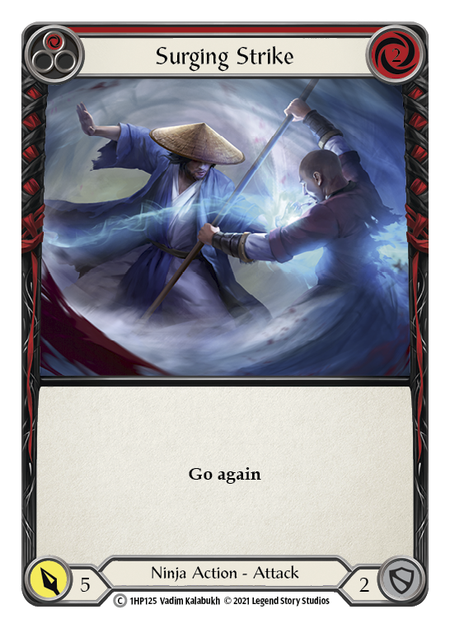
Less obvious is how, when the opponent is at 1 life, each Kodachi swing demands a full card to defend it. This “over-block” situation generates massive amounts of value, because every time they have to block with a 3-defense card, your Kodachi essentially becomes a 1-resource, 3-power go again attack. This specific example is limited to the last life point in the end game, but as demonstrated above, the concept of demanding an over-block is something that can be extended throughout the entire game.
Expert Katsu play lies in consistently generating more value than the damage you present. The key to unlocking this potential is recognizing what your threats look like to your opponent - who can’t see your hand - and leveraging that hidden information to extract as much value as possible from them each turn.
Pass Blocks At Your Own Peril
Some of the most common threats that demand blocks from the opponent are as follows:
- Katsu’s hero ability
- Mask of Momentum
- Whelming Gustwave
- Be Like Water
- Dishonor
We can also add in less common threats like Mugenshi: RELEASE and Breeze Rider Boots. Really, any given 4-card hand presents a massive range of on-hit triggers and potential must-block threats.
As a hero that relies heavily upon on-hit triggers, we need to make sure that our threats force our opponent to block inefficiently as often as possible, and devalue their own offense once their turn comes around. The best way to do this is to spread out must-block threats along the entire chain.
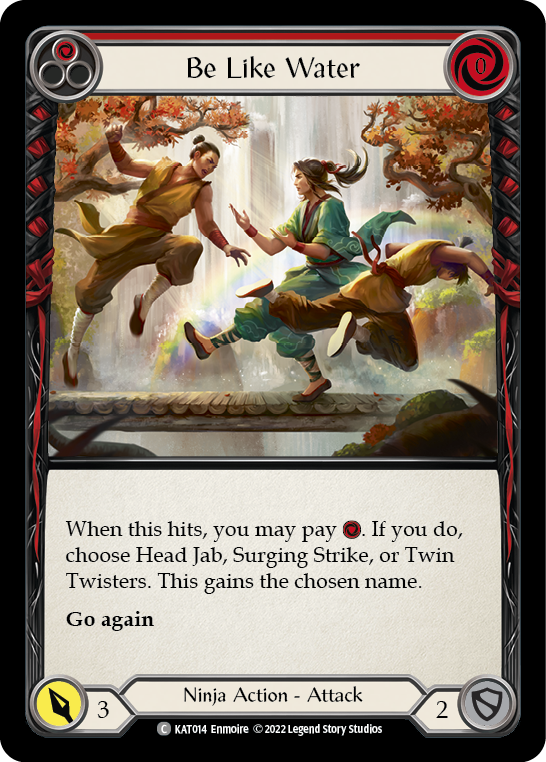
Be Like Water is an incredibly dangerous card to let hit. If it hits, you can pay 1 resource to have it gain the name of your most dangerous combo starter (likely Surging Strike). It also triggers Katsu’s ability to search out the next part of the combo. In a four-card hand, an opponent letting this attack through is taking a huge risk, so they are almost certain to block it.
Consider if you started with two Kodachi swings, then chased with a Be Like Water, hoping to get a Mask trigger as well. You took an attack they were always going to block, and gave them extra value by squandering Kodachi swings you could use to threaten a Mask trigger later in the chain.
Now consider if you opened with a Be Like Water, which was blocked, then attacked with two Kodachis and an Enlightened Strike buffed to 7 power, threatening a Mask trigger. In order to restrict this turn to a fair 12 damage (no free extra card to arsenal), they had to block 3, then block 7. Assuming they even had the armor to cover the Enlightened Strike for exactly 7, you stripped 3 cards out of their hand and likely destroyed whatever offense they may have initially planned.
Similarly, what if you opened with a blocked Be Like Water, then just played a Surging Strike? No doubt they fear you triggering Katsu and searching up a dangerous Gustwave, so now they might be forced to cover the Surging Strike too. God forbid you have a fully charged Tunic to then end with two Kodachi swings and a Fluster Fist to draw off of Mask of Momentum.
The soul of this example is that, in any given 4-card hand, the opponent has no idea what chain links we need to hit in order to take our turn from perfectly fair to game-winningly unfair.
All or Nothing
Having discussed why you would want to space out your threats across the chain, one might get the impression that you never want to compress multiple threats on the same link. However, in the right contexts, this too can severely restrict an opponent’s blocking decisions. The critical component of these scenarios is Breaking Scales.
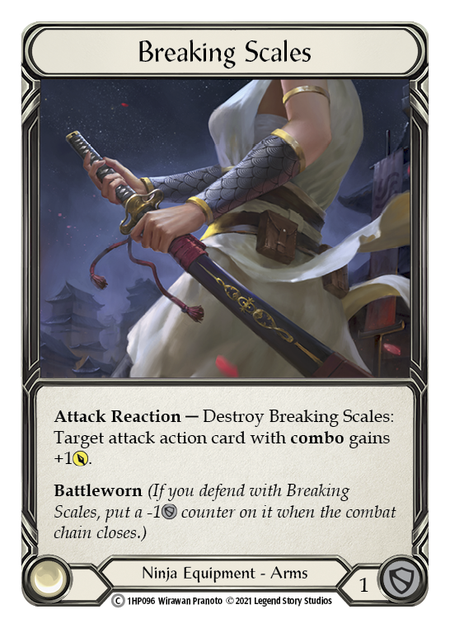
On the surface, Breaking Scales seems quite innocuous. Comparing it straight across to Tiger Stripe Shuko, it both blocks less and will only ever add 1 damage, where Shuko can trigger multiple times a game. In a reductive sense, Breaking Scales forces one attack a game to hit where it otherwise would not. However, due to Katsu’s ability to compress multiple on-hit triggers into one link, that one hit can be a game-losing proposition for the opponent.
An opponent cognizant of this will then have to respect the threat of Breaking Scales and over-block every time they feel the risk is too high. One might then say that the Scales did nothing; however, in reality, it extracted an immense amount of value from the opponent in defense wasted on over-blocks.
Consider this situation: you have been forced to block down to two cards: a blue pitch and a Whelming Gustwave. Your opponent has no more armor. You swing your Kodachis, which go unblocked, and you end with the Gustwave. If this hits, you will get to trigger Mask of Momentum to draw a card, Breeze Rider Boots to give Gustwave ‘go again’, and if you draw a 0-cost card, trigger Katsu to search up Bonds of Ancestry, which in turn searches up a 4-damage Dishonor. A paltry two cards threatens a devastating 13 damage. There are few situations where an opponent would allow this to hit, but without armor, a single 3-block is insufficient - Breaking Scales completely blows them out. As such, they have to commit two cards. Breaking Scales’ mere existence extracted a full extra card from the opponent.
Kicks and Winds
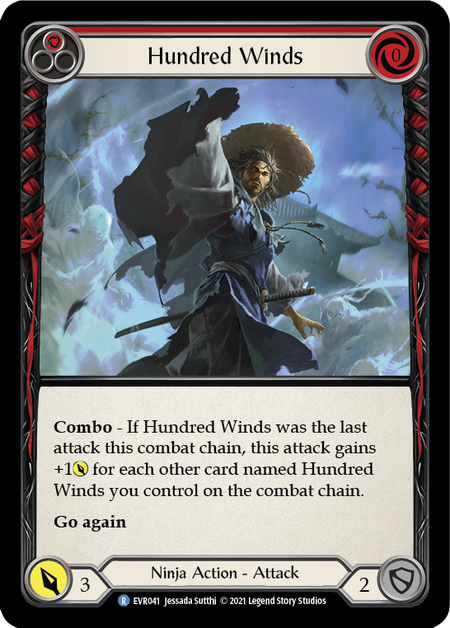
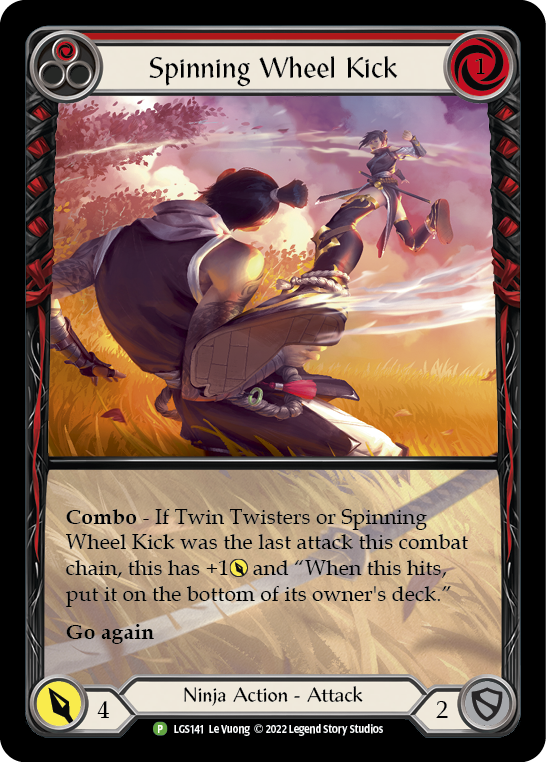
In newer Katsu lists, you may see cards like Hundred Winds and Spinning Wheel Kick. Besides obvious synergy with Bonds of Ancestry, they are ostensibly very fair cards. Even accounting for Bonds turns, you still have to play these cards a few times to get them into the discard.
If we are trying to generate value, why are we interested in playing fair cards? Well, an opponent needs information in order to make effective blocking decisions against Katsu. Combo cards require each piece to be played sequentially, so there's no mystery as to what is coming next. If I play a Surging Strike, the next chain link has to be either Whelming or Descendent Gustwave, or the combo isn’t happening.
If my opponent is committed to a defensive posture, and I lead with Surging Strike, the wheel of options they have to respect is fairly narrow: either I have a natural follow-up in my hand, or I need this to hit in order to search it up. Since it is far more likely that I need to search up the next card, they are going to cover the Surging Strike and try to slam the brakes on my turn. In the event I’m lucky enough to naturally have the follow-up, they’ll likely shrug and block away their remaining two cards - more expensive than they would have liked, but in a statistically nominal game, I can only have it so many times.
Now what happens if I lead with a Spinning Wheel Kick? An opponent committed to blocking with two cards or even their entire hand has no idea where to commit their defensive resources.
- What if I only have the Surging Strike in my hand? Then they should cover the Wheel Kick and the Surging Strike - very expensive for a turn that has no genuine threats in it.
- What if I have Surging Strike and Whelming Gustwave? The previous block leaves insufficient defensive resources to cover the Gustwave, drawing me a card.
- What if I have nothing but blues and I’m trying to draw out blocks to clear the way for two Kodachis and a lame closer threatening Mask of Momentum? They should cover the Wheel Kick to prevent me from searching up a second Wheel Kick to improve my damage, then commit another card to defend a turn that was going to do almost nothing.
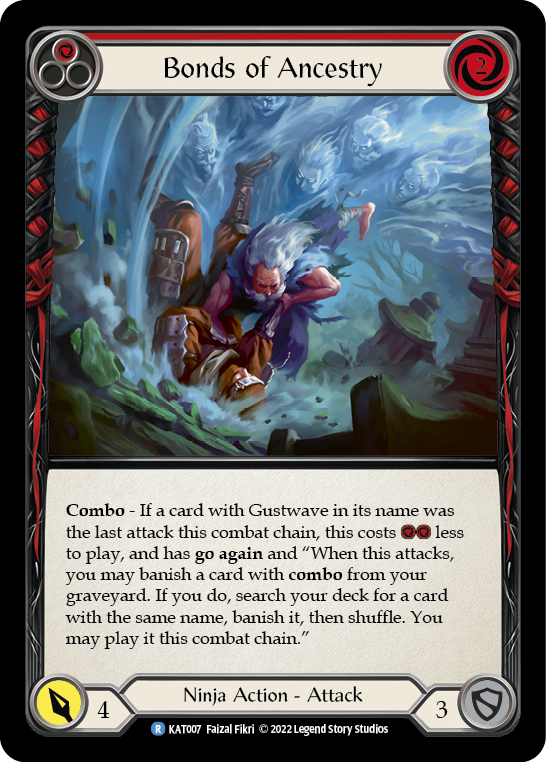
With the addition of Bonds of Ancestry, Katsu can threaten powerful combo turns with nearly any hand size. The range of potential threats is enormous as long as he has more than one hidden card and no combo line on the chain. Nearly every Katsu hand has a “correct” blocking pattern that will minimize the effects of the turn; but the larger the wheel of options he presents, the harder it will be to guess correctly, resulting in more explosive outcomes.
Become the Master
And so we revisit the question - how does Katsu win? In a perfect world where no one blocks him, his immense damage ceiling would close out most games in under three turns. Sadly, people do block, which complicates matters. However, I’m not playing the Ninja class in order to run at people knives out. I aim to conceal information, manipulate risk propositions, and force blocking errors. While the expression “death by a thousand cuts'' may be apt, it’s not just what Kodachis do to life totals - it’s how I constantly demand the small bits of value my opponent has to sacrifice in order to stave off threats they’ll never see coming.






